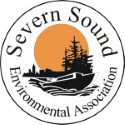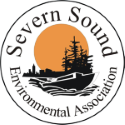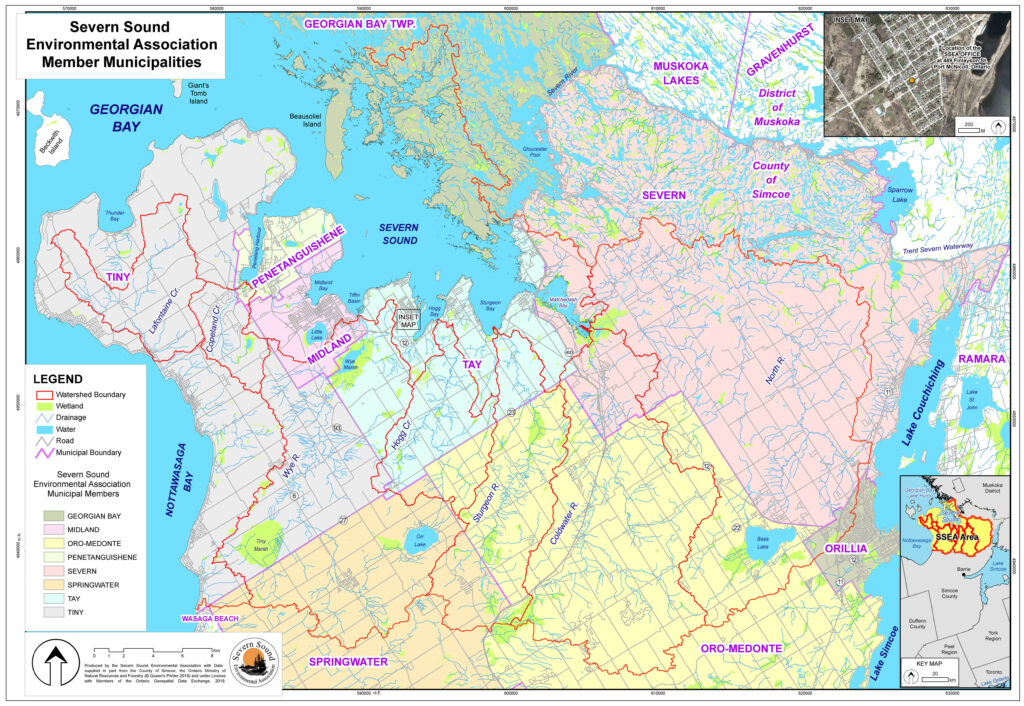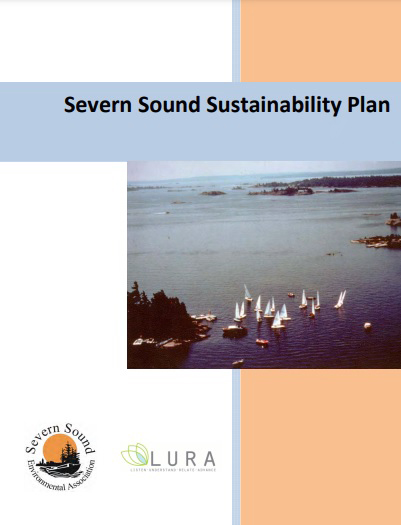Severn Sound Sustainability Plan
Executive Summary
Our Watershed
The Severn Sound watershed is over 1,000 square kilometres, and is located in south‐eastern Georgian Bay. One hundred and ten thousand people live permanently in the watershed, with an additional 200,000 people residing here seasonally.
Nine municipalities along with the County of Simcoe and District of Muskoka are responsible for the continued prosperity of the watershed, protection of the environment, and the health and well-being of the people who live and work here. [The nine municipalities include the City of Orillia, the Towns of Midland and Penetanguishene, and the Townships of Georgian Bay, Tiny, Tay, Severn, Springwater and Oro‐Medonte].
The watershed is under pressure from growth. This growth may lead to a significant impact on the quality of life, the ecological balance, and the economic prosperity of the area if not carefully managed. There are hundreds of government and non‐government organizations whose job it is to ensure the continued health of our watershed. By coordinating our efforts in this Sustainability Plan, we can ensure that the watershed is protected for today, and into the future.
Our Sustainability Plan
The SSEA and its partner municipalities obtained funding from the Federation of Canadian Municipalities in the Fall of 2007 to develop a community‐based Sustainability Plan. A Steering Committee was formed, along with a community based Sustainability Advisory Team to develop the plan. SSEA also attended at a number of community fairs and formed a Citizen Panel. With this input, and support of municipal councils, the Plan’s draft was completed in December of 2008. Based on the success of the Remedial Action Plan, and the Picture This! Our Plan for a Healthy Community processes, the Plan includes a Vision, Goals, Strategic Directions and Actions that will, when implemented, ensure the sustainability of the watershed for generations to come.

Vision
By 2050, the Severn Sound Watershed will contain a network of communities that have achieved a sustainable quality of life for all citizens by developing a common culture of environmental, economic and social balance.

Goals
Goals and strategies have been developed under three “Pillars”- Environmental Sustainability, Economic Prosperity and Community Well-Being.
Environmental Sustainability
Strategies
- Protect, restore and enhance open spaces, forested areas, and natural corridors.
- Preserve, protect, and restore wetlands, and shoreline habitats.
- Identify, protect and enhance special natural heritage features and functions.
- Reduce the number of contaminated sites in the watershed.
Strategies
- Protect native species and habitat from invasive plants, animals and pests.
- Protect rare (threatened) and endangered terrestrial and aquatic plant and animal species from development.
Strategies
Solid and Hazardous Waste
- Eliminate household hazardous and special wastes from landfill.
- Decrease the total annual tonnage of solid waste disposed in landfill over the 2006 baseline.
- Limit the disposal of food and garden waste in landfills.
- Support extended producer responsibility for waste generation.
- Support the goal of a zero waste society.
- Pursue additional alternatives to minimizing the volume of waste disposed.
Energy Consumption
- Develop alternative energy plans that consider using solar, wind, and geothermal sources.
- Implement conservation initiatives.
- Inventory data on energy consumption and monitor progress towards goals.
Water Quality
- Protect surface and ground water from contaminants through the watershed’s Source Water Protection Plan.
- Minimize contaminants to surface and ground water from storm water collection and discharge systems.
- Ensure sufficient sustainable sewage treatment plant capacity and treatment to accommodate the growing population.
Air Quality and Climate Change
- Develop a coordinated plan to reduce our impact on climate change and develop adaptation strategies.
- Improve air quality within the watershed to ensure compliance with provincial air quality standards.
Strategies
Transportation Facilities
- Reduce the impact that transportation has on the watershed’s contribution to greenhouse gas emissions (GHGs).
- Implement the Simcoe County Transportation Master Plan.
- Develop municipal plans that focus on mass transit, including car pooling, implementing connecting trails, and encourage micro-private sector initiatives such as community buses.
Water Quantity and Supply
- Ensure a reliable potable water supply for all residents and visitors.
- Reduce water consumption through water conservation measures.
- Develop a water and wastewater plan based on growth targets.
Urban and Rural Development
- Decrease urban sprawl and encourage more compact development patterns.
- Continue to protect natural areas, parkland, agricultural lands and woodlands (both urban and rural) from encroaching development.
- Promote and encourage “green building” design, development and construction through the achievement of Leadership in Energy and Environmental Design (LEED) standards set by the Canada Green Building Council or equivalent programs.
Strategies
- Promote the establishment of school programs that create awareness of local natural and cultural environments and sustainable living.
- Increase cooperation among schools and environmental/socio‐cultural groups for public education programs about environmental stewardship.
- Support local non‐government organizations to provide environmental education opportunities.
Community Well-being
Strategies
Safety
- Reduce motorized vehicle collisions/crashes and fatalities.
- Improve the safety of alternative transportation modes, particularly cycling.
- Decrease crime within watershed communities.
- Promote safe hunting.
Health & Health Services
- Improve overall health of residents.
- Promote safe and healthy work environments.
- Continue preparedness for Pandemic and Emergency Planning.
Recreation Services
- Provide a variety of structured and unstructured recreational services and facilities that are physically and financially accessible for all ages and abilities.
Healthy Community Design
- Develop policies to promote the design of communities that are livable, attractive and healthy.
- Develop a community whose citizenry has a strong sense of personal and spiritual well‐being.
Strategies
- Provide alternative housing types and sizes to meet the needs of all demographics, all income levels at all stages of life.
- Reduce homelessness within watershed communities.
Strategies
- Create a network of interconnected trails and walkways throughout the watershed.
- Increase awareness of wilderness opportunities in the watershed.
- Increase collaboration between municipal governments and other organizations to provide active living, leisure and educational services.
Strategies
- Promote art, culture and heritage in the Watershed.
- Conserve natural and built heritage facilities and landscapes.
- Implement heritage conservation guidelines.
Strategies
- Continue to recognize and promote volunteerism within the community.
- Continue to support volunteer initiatives, including monitoring, that are aligned with this Sustainability Plan.
- Promote and enhance awareness and usage of community networking services and similar initiatives.
Economic Prosperity
Strategies
Economy
- Develop strategies or enhance support for business retention and expansions.
- Investigate opportunities for the Watershed to implement a Clean Technology plan and strategy.
- Provide support, tools and incentives for existing business to become “greener” through energy, resource and process efficiencies.
- Promote ecologically appropriate entrepreneurship within watershed communities.
- Develop a formal business attraction policy for the area
Employment
- Improve/increase availability and awareness of employment opportunities.
- Improve wages/affordability of living to keep people in the community.
- Improve the number of opportunities for green businesses.
- Improve educational apprenticeship programs in the watershed.
Strategies
- Access funds to increase availability of high speed/wireless Internet.
- Promote awareness of Internet capacity to support business development and expansion.
Strategies
- Expand, enhance and promote eco-tourism.
- Expand, enhance and promote cultural tourism.
- Expand, enhance and promote culinary tourism.
- Work with industry professionals to re-evaluate the direction of tourism given the stressors indicated.
- Work with tourism operators to identify opportunities to improve operational efficiency while minimizing environmental impact.
Strategies
- Maintain vibrant downtowns as the commercial, cultural and social focal points of the communities in the watershed.
- Support retention and development of local farmers’ markets (Orillia).
- Promote initiatives that support local purchasing.
- Support beautification efforts.
- Promote pedestrian space and friendliness.
- Promote downtown festivals and activities.
Strategies
- Develop and implement an action plan to improve the economic viability of agriculture in the region.
- Strengthen local connections between the production and consumption of goods and services.
- Develop a farm land trust to purchase land from retiring farmers at market prices.
- Support the development of educational programs for sustainable agriculture.
- Create financing strategies and programs to support transition to sustainable agricultural practices like organic certification
- Promote purchasing of local foods by all municipal governments, hospitals, educational institutions, grocery outlets, restaurants and residents.
Next Steps
Now that the Plan is complete, a Sustainability Plan Steering Committee (SPSC) has been established to develop a plan for its implementation. In addition, partner organizations will be encouraged to participate in the Plan’s implementation by “adopting” strategies and actions for implementation. The Steering Committee consists of representatives from the 9 member municipalities, the SSEA, the Orillia Area Community Development Corporation, the North Simcoe Community Futures Development Corporation, the Simcoe-Muskoka District Health Unit, and the County of Simcoe.
Any ideas and input for actions to implement the Plan are welcomed. To send your feedback,
please contact the SSEA Office at – sseainfo@severnsound.ca or 705-534-7283.



